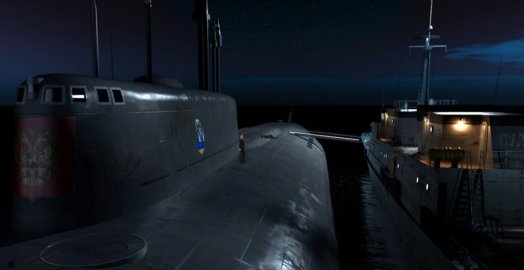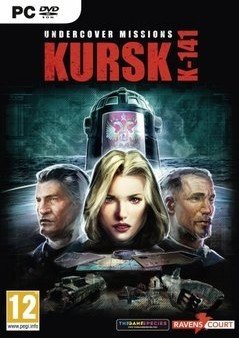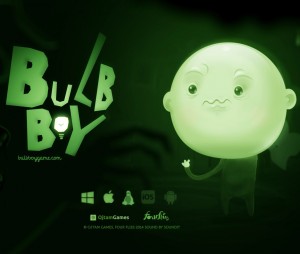Review for Undercover Missions: Operation Kursk K-141

Much like the Russian nuclear submarine it’s named after, The Game Species’ nautical point-and-click adventure Undercover Missions: Operation Kursk K-141 suddenly and stealthily surfaced into view with little advance notice or fanfare. But perhaps the lack of publicity was strategic, as the game comes across as a less-than-sterling effort, with a dead-end plot, “sometimes you see them, sometimes you don’t” inventory items, and voice acting so wooden the main characters may as well have been voiced by Microsoft’s text-to-speech Sam, Mike, and Mary.
The story is essentially a flashback leading up to the events of the sinking of the Russian submarine. The game opens with a conversation, two disembodied voices discussing characters and events that, at this point, mean absolutely nothing to the player. Unfortunately, most of them will remain utterly meaningless as the game moves on; whether due to poor writing or a clumsy translation from its native German, suddenly referencing names and events purely out of the blue becomes Operation Kursk’s modus operandi.
It is worth mentioning that the Kursk was, in fact, a real Russian submarine that sank in 2000. However, the game isn’t a factual retelling of that event, but rather an alternate take that is loosely based on the tragedy. Players take control of Russian agent Milena Belyaeva, who is assigned to infiltrate the Kursk undercover while on the trail of a criminal organization that is suspected of staging a coup to steal the vessel. All of this is communicated over the course of the game’s first of nine chapters via stilted dialog and banal environments.
Once aboard the Kursk, the game attempts to build up some speed, and partly succeeds in doing so. Controls are as straightforward as can be: left-click to take or interact with an item or talk to a person, right-click to examine something. An inventory bar will pop up at the bottom of the screen when the cursor is moved there. There is a hotspot locator (which also reminds you of your current task), and an object’s name is displayed when hovering the pointer over it. Players must search each location, collect items, and use them to solve logic puzzles to progress in the story. The problem is, each step along this path is plagued by unfortunate design choices, boring visuals, and a story that is no less transparent than the steel plating of the hull.
The game’s first and foremost offense lies in its poor puzzle design. Often, despite knowing what needs to be accomplished and where, arbitrary roadblocks are thrown up by making it way too complex to even find critical items. Early on, for example, a mundane object sitting on a desk will trigger a throwaway line of dialog when examined. However, a critical item underneath it cannot be accessed until players reach a certain point in the game, after which Belyaeva will pick up the item when clicked upon again, revealing what’s hidden underneath. No clue is ever given to go back and check out the object – the game not only encourages but demands continuous clicking of every random object in the environment, sometimes repeatedly, to succeed.
Due to such artificial restrictions, I routinely got stuck without a necessary item to proceed, forcing me to consult an online guide several times. At one point a character I spoke to sent me to another location to accomplish a task, only to find out I was lacking a necessary tool when I got there. Eventually – and by sheer happenstance – I found out that I needed to go back and speak with the same character one more time, who then presented me with the tool he knew I’d need all along. The game is absolutely filled with these “click on everything again, it may have a new function now” moments. Obtaining a crucial item may require clicking on an area two or three times, even re-clicking an area that was cleaned out in an earlier chapter. Worse, some items that require multiple clicks aren’t even visible on screen, lacking any tangible indication that you should even try looking there. I never truly felt like I progressed through the adventure based on cunning, but rather on finding an item or activating an event through blind luck and dumbly clicking all over.
Puzzles appear in more common but equally frustrating forms as well. Tasks requiring you to assemble an item, fit Tetris blocks into a certain shape, or spot differences between two images are as mundane as they are simple. More egregious are the “number sequence” puzzles, not due to their difficulty but rather because the clues to solve them – if found – only offer piecemeal solutions, making some amount of trial and error unavoidable. And it’s not enough to solve these puzzles once; each shows up multiple times throughout the course of the game. The only time I ever felt I was really using my brain was to crack an encrypted message by perusing documents for clues and cracking an alphabetical cypher on my own. Sadly, this was the lone puzzle type that showed up only once during the game.
The environments themselves are nothing special, ranging from simple to drab. The majority of the game takes place in a confined space, with usually no more than four or five rooms accessible at any given time. Making matters worse, having three of the sixteen total rooms be near-identical cabins, an additional two being identical torpedo rooms, and one more that’s never used keeps the variety of locations pretty low. From the outset, you are provided with a map of the submarine, which takes care of navigating from one location to another rather than the conventional room-to-room maneuvering (with a few late exceptions outdoors). Achieving objectives, finding items, completing chapters, and talking to characters sometimes enable new rooms to travel to, while closing off others no longer required. At no point do you have access to the full sub.
Even within these limited environments, Operation Kursk is no visual feast. The third-person graphics are merely passable in attempting to look realistic, and not much is done with them in the way of animation. As a rule, actions that require animation are covered by a fade-to-black rather than being displayed, up to and including multiple fades in short succession. Often your imagination is called on to fill in the blanks, as when a character stops a few feet short of a sink and stares at it, rather than actually using it.
Just as little effort was made to ensure a quality audio production. Almost all of the voice acting is flat and listless, some characters having over-pronounced or inexplicably absent Russian accents. The quality of the vocal recordings even fluctuates, sometimes from line to line. One piece of dialog will sound clear, the next as if recorded through a tin can or from far away. In fairness to the performers, however, it is sometimes difficult to judge if the script is butchered by the wooden delivery or if the translation is so poor that the actors simply had no way to punch it up.
There is even less to celebrate in the way of music, as the majority of the game – with the exception of the menu screen – is one long, repeating humming chime that fades in and out until you simply tune it out altogether. When the best aspect of the audio production are the simple but serviceable sound effects, Operation Kursk is perhaps better played with its sound completely turned off, though the options allow muting each element separately.
Eventually the plot moves past the tangled mess of disconnected names that make up the first few chapters, but things don’t improve as they go along, only simplify. Chapters begin to feel stuffed with reused and recycled content. I must have picked up at least four or five separate screwdrivers in various chapters, only to unscrew a panel before losing it again, and I started to lose count after the third time I had to find, assemble, or repair a gas mask to protect myself from some incapacitating gas or another. The game has a bad habit of removing half of your inventory items whenever a new chapter begins, sometimes replacing them with others that show up unannounced, even when they’re evidently not needed.
One especially notable instance of this occurred near the end, when a section of a previous chapter is replayed, slightly altered, as part of a fill-in-the-blank flashback. However, the second time through the familiar sections, Milena’s inventory is slightly different, including some items that weren’t previously there. It’s these small (and sometimes not-so-small) inconsistencies that cast the game in a slapdash light.
Where gameplay isn’t always satisfying, one can still hope the story might throw a lifeline, but there’s no rescue here. Agent Belyaeva follows up on one objective or another pretty consistently, whether she’s narrowing down a list of suspects for a sailor’s assassination or stealthily overpowering armed guards. But the characters aren’t written or portrayed in a way that makes any of them likable or worth remembering, and the plot never feels meaty enough to sustain deep engagement. I felt like I was continually reacting to events, rather than proactively uncovering a larger mystery.
Not only is the plot uninteresting, but here’s an example of just how obfuscated it is. The story opens with the reveal that the Kursk does in fact sink, killing everyone on board. Throughout the course of the game, you’ll work diligently to defuse all potential threats that arise. By the time the credits rolled, I felt I had succeeded in thwarting the bad guys and saving the sub. In fact, the poor translation seemed to confirm that I had succeeded in doing just that. Only by doing some independent research was I reminded that, oh yes, the game told me the sub would sink. So either Operation Kursk is hopelessly mistranslated beyond repair or can’t stay faithful to its own historical plot. I suspect that most players who get that far will be too relieved to finally see the credits roll to care much one way or the other.
And that is perhaps the best way to sum up my experience with Undercover Missions: Operation Kursk K-141. There aren’t a lot of adventures based on historical naval disasters, which offer an inherently exciting premise, but Undercover Missions: Operation Kursk-141 does not make a strong case for more. Though it is occasionally playable, it delivers satisfaction neither with its confusing plot nor its awkward design choices, so after slogging through its nearly-ten-hour campaign, I was happiest to finally see it sink back below the murky waves of oblivion.
































